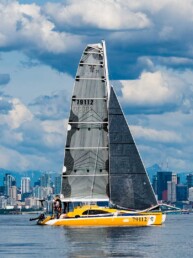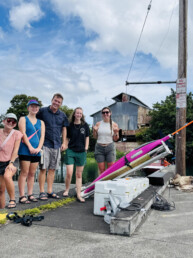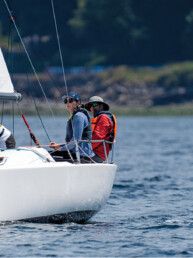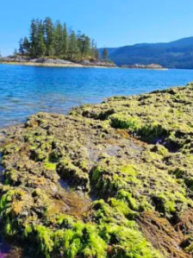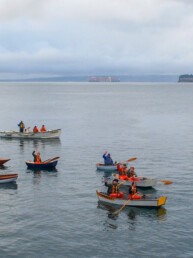 The Puget Sound Cruising Club (PSCC) celebrated its 50th anniversary on Friday, November 17. As fitting with the club’s traditions, it was a potluck — a feast, in fact — with PSCC providing a huge ham and everyone else chipping in with side dishes, salads, a cake, and more. Every seat was taken and cries of delight went out as members greeted others they hadn’t seen for years.
The Puget Sound Cruising Club (PSCC) celebrated its 50th anniversary on Friday, November 17. As fitting with the club’s traditions, it was a potluck — a feast, in fact — with PSCC providing a huge ham and everyone else chipping in with side dishes, salads, a cake, and more. Every seat was taken and cries of delight went out as members greeted others they hadn’t seen for years.
The anniversary provided an occasion to look back fondly on the first PSCC meeting my husband, Steve, and I attended in 1978, at North Seattle College. I remember the lights of the auditorium going down and a picture on the screen of children diving from a sailboat in the South Pacific. “Cruising strengthened our family,” Jerry Jacobs, the presenter and one of the founding members of PSCC, said. Later in the talk, he showed their boat approaching a landfall under threatening skies. “At that time,” he said. “I would have traded our boat for a plow in Kansas.” I thought of Velella, a Rhodes design sloop, that Steve and I had just sailed from the east coast. It had tossed like a cork in giant waves in the Gulf Stream. I wouldn’t have traded Velella for a plow in Kansas, but I had longed to be back in the house we had sold in a Philadelphia suburb. “Are we crazy?” I asked myself more than once while clinging to Velella’s cockpit coaming.
That voyage, from Boston to Seattle, was intended to be as much a journey home for us as a sail to exotic places. Six years before, both of us had graduated from the University of Washington. Steve, a newly commissioned naval officer, was sent to a destroyer in Newport, Rhode Island, where I found a job in my UW major: oceanography. We bought a trailerable 21-foot swing-keel sailboat and sailed it around Narragansett Bay, in the Cape Cod area, and Maine. We learned what to do with a swing keel when you run aground — crank it up and keep sailing. Three years after that, the Navy assigned Steve to the Philadelphia Navy Yard to repair submarines for foreign nations. I got a job in downtown Philadelphia writing Environmental Impact Statements. We bought Velella, a full keel sailboat and, when sailing in the Delaware River, learned what to do when you go aground in a boat with a full keel (you kedge: drop an anchor in deeper water and haul the boat to it). We began thinking of taking Velella offshore. Then, we discovered Velella’s delaminated decks. We learned how to rebuild fiberglass decks by using epoxy, elbow grease, and help from friends. Despite the delays and frustrations, the work we did put us in a good position to take the boat offshore. We knew how to do repairs, and had confidence in ourselves and Velella.
Finally, with Steve’s Navy obligations behind him, we departed for Seattle. We first sailed north to Boston to say goodbye to family and friends, then turned south through the Intracoastal Waterway to our “jump off” point, Charleston, where we encountered those gigantic Gulf Stream seas. From there, we headed through the Caribbean Islands, then to the coast of Venezuela. Approaching a Venezuelan submarine in Puerto Cabello, I feared getting shot. But one of the submarine’s officers recognized Steve from the Philadelphia Navy Yard and invited us aboard, eventually serving as our guide to Venezuela. From Venezuela we transited the Panama Canal, cruised north to Acapulco, Mexico, then crossed the Pacific to Hawaii and finally headed to Seattle.
A week away from Cape Flattery while motoring in a calm, we made a short diversion to pick up a glass ball, only to wind a rope around our propeller and break the propeller’s coupling in the process. Unable to use our engine, we sailed through the calms, into the Strait of Juan de Fuca and Puget Sound, to the Ballard Locks. There we hailed another sailboat to tow us through the locks and help us to our new moorage at Ewing Street Moorings.
The sailboat that gave us a tow brought us to the entrance to the marina, where hands reached out to pull Velella to the dock. One of the welcoming party, a middle-aged man named Art, looked over Velella, inspected her worn varnish and frayed lines, noted her Philadelphia homeport, then looked us in the eyes, and said, “You should be members of the Puget Sound Cruising Club. I’ll take you to the next meeting.”
As I sat in the auditorium during my first meeting, listening to the resounding applause after Jerry’s talk, I realized that most of the audience dreamed of sailing to far-away places as Steve and I had just done. We had found our boating home.

A Cruising Club, Not a Yacht Club
In November 1973, a small group of cruising sailors organized a meeting in the Seattle office of the now defunct cruising magazine Castoff. Their intent was to gather people interested in local and bluewater cruising. They expected only a few people to attend, but sailors crowded into the room, eager to hear a talk on cruising in Hawaii. Two attendees of that meeting were instructors at the North Seattle Community College, who arranged for the next meeting to take place in an auditorium in the College. (PSCC now meets at the Puget Sound Yacht Club on North Northlake Way in Seattle on the third Friday of the month at 7 p.m.)
By 1978 when Steve and I learned about PSCC, cruising had become an aspiration for many boaters. Lin and Larry Pardy’s injunction to, “Go small, go simple, but go now,” had inspired many to head out in small boats. Sailing World magazine, established in 1975, also spread the word. Our Chesapeake 32 sloop fit right in with the many other cruising boats headed out at that time including older boats like Alberg 30s and new ones like Bristol Channel Cutters.
“We’re a cruising club, not a yacht club,” is a statement frequently heard among PSCC members, often with emphasis as if to dare anyone to claim otherwise. Unlike many yacht clubs, PSCC doesn’t own its own building, doesn’t charge a membership fee, and doesn’t require an application to join. PSCC also does not have an elected bridge of officers — just a commodore. For years, commodore candidates were nominated or volunteered and were elected at the next meeting. Then, one year someone nominated Jay Maxwell who wasn’t present at the meeting. Someone else nominated Sue Maxwell, Jay’s wife, also absent. We decided they should choose and let us know the next month. But when they came to that meeting, they announced to the crowd that they would both be commodore. That started a run of about 10 years of married couple commodores until one of the partners rebelled and the club went back to a one-person commodore.
Does the casual method of electing commodores make the process difficult? Yes. We’ve had cliff-hanger years when no one volunteered until the last minute, including this year when it was down to the wire until a relatively new member, Sheri Medley, stepped up. Her enthusiasm for sailing and love of fun promise a good year ahead.
PSCC didn’t charge admission in its early years, merely putting a coffee can on the table for for voluntary donations of $1 a head. There were always enough donations until the time Robin Lee Graham, author of the book, Dove, gave a talk to the club. The auditorium was packed with members of the audience sitting in aisles. We worried about the fire marshall showing up to close us down. Expecting lots of donations from so many people, we were dismayed to find our coffee can still almost empty by the end of the meeting.
It was time to get serious. We raised our fee to $2 and started collecting it at the door. There was dissent; some members resigned. We now have a volunteer treasurer who collects money (or PayPal) at the door and keeps track of our kitty. The funds help us pay for rent for a one-evening-per month use of a building and other minor costs.

Puget Sound Cruising Club Today
Puget Sound Cruising Club meets monthly (except in July and August when members are out cruising) at the Puget Sound Yacht Club on Northlake Way in Seattle. The weekend after most meetings they cruise to a local destination. Although club members insist they are not racers, PSCC usually hosts two quasi-races a year. The first is around Bainbridge Island, with racers choosing to go either way around. There is no first place, and second place takes honors. In the Tequila Race, racers vie for a bottle of tequila but the winner is determined by an unannounced list of quirky handicapped rules and must pour drinks for everyone else.
In 2022 PSCC started a new tradition — organized group flotillas. Unlike professional flotillas, they don’t have a leader, just an organizer. Flotilla members all participate in collecting information for the cruise. PSCC’s 2022 flotilla was to Princess Louisa Inlet. The 2023 flotilla was to Barkley Sound and included seven boats, four who ventured out the Strait of Juan de Fuca and three who came from around the top of the island. In 2024, PSCC’s flotilla will head north to Desolation Sound.
To become a PSCC member, boaters only need to buy a burgee and sign a roster. Guests are always welcome. Members and guests pay either a $5 voluntary entry fee at each meeting or a $50 annual fee. PSCC has never refused entry for not paying.
Inspiration comes from the monthly meetings that always include a speaker — usually a cruiser who has returned from distant places; a local expert on sail making, boat design, or boat building; or perhaps someone that a member meets on the dock who sounds interesting. The best speakers, who draw the biggest audiences, tend to be returning club members. Today, members returning from the South Pacific, Europe, or elsewhere make up a healthy percent of our meeting attendees.

Puget Sound Cruising Club Members
Puget Sound Cruising Club burgees can be found flying in clubs and marinas around the world. Looking back over the years, some member accomplishments stand out. I think of our friends, Candy and David Masters, who completely rebuilt their 1962 steel yawl, Endeavor, over a period of 15 years, then sailed south around Cape Horn. In Patagonia, they took a National Geographic camera crew to waters rarely explored. After a stint on the U.S. Atlantic coast, they sailed north via Iceland to Ireland and Scotland then to England. The Seven Seas Cruising Association awarded them the Seven Seas Award in 2018, one year after David had passed away.
Barbara and Jim Cole were in Malaysia when the pandemic started. Via Zoom they kept the Cruising Club up-to-date on their circumnavigation on their Halberg Rassy 36, Complexity (pictured in this article’s feature image). Stranded at sea by the pandemic, they were forced to choose between the Indian Ocean route to South Africa and the Red Sea route to the Mediterranean, with potential risk of pirates. They chose the Red Sea, eventually making a successful transit to arrive in the Mediterranean.
Ginger and Peter Nieman, who have shared stories in 48° North previously, departed in 2017 for their second circumnavigation in their 52-foot converted schooner Irene. Their first circumnavigation had been westabout from Seattle rounding the Cape of Good Hope and Cape Horn. On this second trip, they went east through the Northwest Passage. Stranded in Turkey during the Pandemic, they chose to head home going east through the Suez Canal. This nonstop voyage across the Indian Ocean during the monsoon season was rough and required extraordinary perseverance. For this accomplishment, the Cruising Club of America presented them with the 2021 Blue Water Medal.
I’m proud that, thanks to the Puget Sound Cruising Club, sailors like these are my friends. Cheers to these first fifty years! The only thing more exciting than the education, support, community, and inspiration PSCC has facilitated in its first half-century through meetings, potlucks, raft-ups, and now flotillas, is the ways it may continue to do so for Puget Sound cruisers in the future.
Elsie Hulsizer is the author of Voyages to Windward: Sailing Adventures on Vancouver’s West Coast (Harbour Publishing 2005, 2015) and Glaciers, Bears and Totems: Sailing in Search of the Real Southeast Alaska (Harbour Publishing 2010). In 1985 Elsie and her husband Steve Hulsizer sold their Chesapeake 32 Velella and purchased Osprey an Annapolis 44, which they cruised extensively in British Columbia and Southeast Alaska. Osprey is now for sale.
www.elsiehulsizer.com/www.sailblogs.com/member/ospreyvoyages
Visit pugetsoundcruisingclub.org for more information including information about future meetings and cruises. All are welcome.

